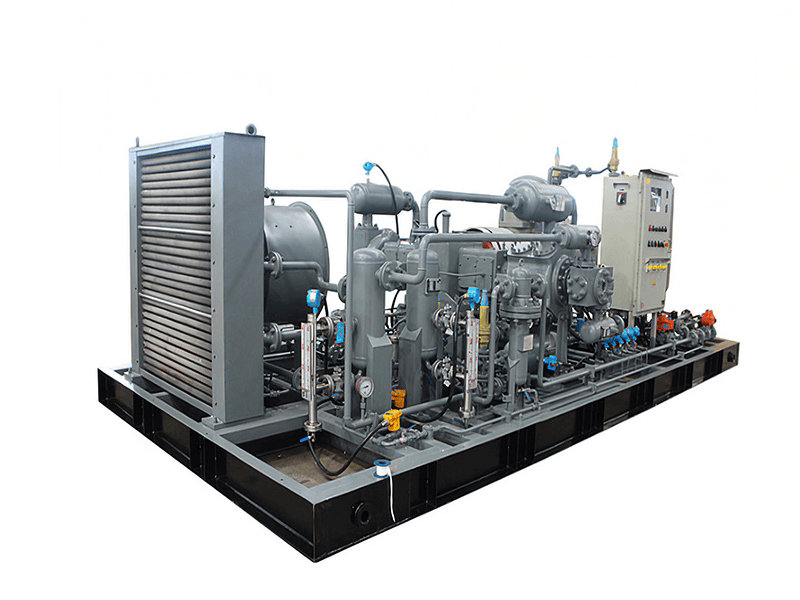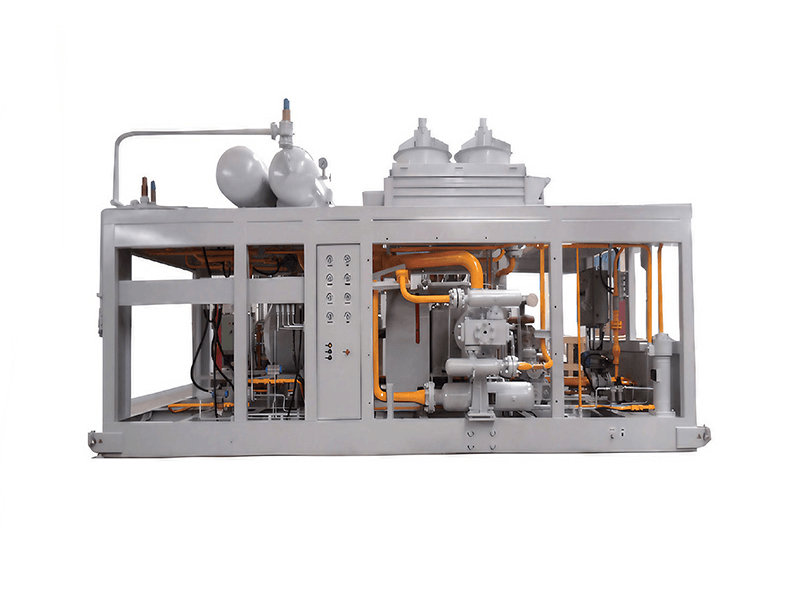In the gales of the North Sea, the "Blue Whale" drilling platform stood like a solitary island. Deep within its lower-level engine room, three screw compressors, coated in explosion-proof yellow paint, roared at 3600 revolutions per minute, compressing sulfur-laden associated gas to 8 MPa. Every breath of these steel behemoths determined whether the entire platform could transform the treasures of the seabed into flowing wealth—this is the destiny of compressors in the oil and gas industry: providing the pulsing power for the energy bloodstream amidst the hellish conditions of high temperature, high pressure, and high corrosion.
I. The "Pressure Translator" of Subterranean Energy
When drill bits penetrate three thousand meters of rock, crude oil gushes forth laden with dissolved gas. The sudden pressure drop turns escaping gas into a lethal challenge. The 2010 investigation report into the Gulf of Mexico's "Deepwater Horizon" disaster revealed: a compressor failure in the well control system allowed natural gas to breach the mud barrier, ultimately triggering the most severe offshore oil spill in human history. Since then, compressors have moved from the background to the forefront, becoming the life-or-death valve for oil and gas safety.
Pressure Hubs on the Oil & Gas Chain:
Wellhead Boosting
At the Karamay Oilfield in Xinjiang, pumpjacks bobbed like mechanical woodpeckers. As extraction deepened, wellhead pressure dwindled from an initial 12 MPa to 0.8 MPa. Reciprocating compressors then sprang into action; 24 cylinders coated with special ceramics worked in unison to force residual gas from depleted wells back into the formation. This system boosted recovery rates in the aging field by 19%, equivalent to extracting an additional 4.3 million tons of crude oil.
2. Conqueror of Associated Gas
On a Bohai Bay drilling platform, seawater and sand particles carried by associated gas could wear through an ordinary impeller in just three days. The solution here was twin-screw compressors: rotors treated with special boronizing engaged with a 0.1mm clearance, while injected sealing oil formed a liquid film barrier. Even with sand content as high as 120 mg/m³, the units ran stably for 8000 hours—equivalent to 333 days of uninterrupted operation.
3. Powerhouse of Long-Distance Pipelines
Along the "Power of Siberia" pipeline stretching from Siberia to China, a compression station sits every 200 kilometers. Inside these stations, centrifugal compressor impellers, 1.8 meters in diameter and forged integrally from nickel-based alloy, spin at 9800 rpm. A single unit propels 400 cubic meters of natural gas per second across the permafrost—equivalent to filling two Olympic swimming pools every minute.

II. Breaking Through Technological Limits: A Matter of Life and Death
1. A Metal Revolution in High-Temperature Hell
Inside a compressor house at Kuwait's Burgan field, instruments showed an intake temperature of 63°C. Ordinary lubricating oil drastically lost viscosity at this temperature, causing seal failure. Engineers deployed a dual countermeasure:
Synthetic ester oil: Flash point raised to 246°C (70°C higher than mineral oil)
Plasma-sprayed coating: Cylinder liners covered with a 0.3mm layer of chromium oxide, reducing the friction coefficient to 0.08.
This system extended the compressor overhaul cycle to 48,000 hours in the desert environment, comparable to nuclear power plant standards.
2. A Sealing Miracle in Deep-Sea High Pressure
Operating at 1500 meters depth at the "Deep Sea No.1" energy station in the South China Sea, compressors faced a terrifying challenge: external water pressure of 15 MPa versus internal gas pressure of 25 MPa. The sealing system here was akin to dancing on a needle's point:
Triple dry gas seals:A 0.5-micron gap forming a gas film barrier.
Silicon carbide seal rings:Hardness second only to diamond.
Monitoring data showed average daily leakage of less than 5 standard cubic meters—barely equivalent to three days' gas consumption for a household stove.
III. Bloody Lessons Forge Safety Codes
The Alaska Pipeline's Wake-Up Call (1986): At Prudhoe Bay, a failed compressor anti-surge system caused pressure fluctuations that triggered pipeline resonance. Within 90 seconds, 347 kilometers of pipeline twisted and ruptured like a giant serpent, spilling 8000 tons of crude oil that stained the tundra red. This accident birthed API 618 Standard clause 7.3.9: All oil and gas compressors must be equipped with dual-channel anti-surge controllers with response times under 50 milliseconds.
Moment of Life and Death on a Caspian Platform (2021):On an Azerbaijani platform, hydrogen sulfide concentration in the compressor room suddenly spiked to 800 ppm. The intelligent system instantly activated three levels of defense:
1. Magnetic couplings cut off power (0.3 seconds).
2. Rupture discs released high-pressure gas (1.2 seconds).
3.Caustic spray system covered the leak area (2.8 seconds).
This multi-million-dollar protection system suppressed the H2S concentration back below the safety threshold within 17 seconds.
IV. China Manufacturing's Path to Breakthroughs
The Sichuan Shale Gas Campaign: Amidst the cliffs of Weiyuan County, Sichuan, compressor units battled the "well killer"—the pressure decline curve. When shale gas well pressure halved just three months after production, China's domestically developed hydraulically driven compressors proved formidable:
No external power needed, diesel-driven hydraulic pump.
Modular design transportable by helicopter.
Result: Well recovery rates increased by 34%, recouping equipment costs in just 11 months in areas without grid coverage.
he Ultra-Deep Well Challenge: In the Tarim Basin, facing 140°C gas from 8000-meter wells, traditional compressor lubricants coked and failed. Baosteel Special Materials Institute's solution stunned the industry:
Self-lubricating ceramic piston rings:Containing molybdenum disulfide nanowhiskers.
Gradient alloy cylinder liners: Surface micro-pores designed for oil storage.
Field tests showed wear rates only 1/7th of comparable international products under harsh conditions with 2.3% sulfur content.
Epilogue: The Future Frontier of the Art of Pressure
As the global energy transition surges, compressor technology is undergoing revolutionary transformation. In Norway's North Sea, all-electric compressors have reduced platform carbon emissions by 42%. In Abu Dhabi, AI control systems, learning from 100,000 pressure waveforms, have boosted efficiency to 98.2%. Within China's "Deep Sea No.2" energy station, magnetic levitation compressors propel 15 billion cubic meters of natural gas eastward in a frictionless state.
The compressors of the oil and gas industry are like silent master craftsmen—they transform the Earth's core energy into the lifeblood of modern civilization, scripting the eternal contest between human ingenuity and natural forces within the rhythm of steel. Every piston stroke is a resounding beat in the industrial epic; every sealing interface marks the pinnacle of materials science. Pulsing within these cold machines is the fiery soul of the entire energy era.


























